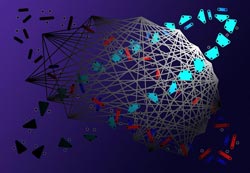Embedded nerve cells hold the key to brain activity

For a network of five elements, the combinations to be tested to ascertain each unit’s effect are already 52 (shown as orbiting symbols). Hence, this traditional way to investigate brain function is useless in most cases (Image: Grah/BrainLinks-BrainTools, symbols: Mate2code, Creative Commons).<br>
Understanding complex systems such as the brain of mammals: Dr. Arvind Kumar and colleagues from the Bernstein Center and the Cluster of Excellence BrainLinks-BrainTools at the University of Freiburg present a new view on brain function.
Much of today’s brain research follows an approach that has been in use for decades: An area of the brain is either silenced of augmented in its activity, and the resulting effects in other parts of the brain – or in the whole organ – are measured. While this approach is very successful in understanding how the brain processes input from our senses, a team of scientists from Freiburg argues that it is too simple when trying to understand other brain regions. The team presents their findings in the current issue of the journal “Trends in Neuroscience”.
“The traditional approach reduces the brain’s enormous complexity by defining relatively arbitrary subunits”, Kumar and his colleagues explain. For this abstraction to work, information must flow in one direction only. But this is not what happens in the brain, which is a complex network of smaller sub-networks that allows feedback to preceding units. Even for a network of ten units, unraveling each unit’s function would require more than 100,000 individual experimental setups – an impossible task.
“Perhaps, the main question in understanding the brain is not so much how a particular area affects the activity of others, but rather how exactly brain activity can be changed from one state to another”, Kumar states. For this purpose, the neuroscientists introduced a new quality of nerve cells: their embeddedness. This is a measure for the role that a neuron plays within a network. It combines data about where a nerve cell receives information from, where it connects to, and how much it contributes to the whole network. The researchers combine this idea with the insight that already a limited number of elements within a network can control its overall behavior. Concentrating on these ‘driving neurons’ promises that even manipulating only a small number of nerve cells will provide new insight about the dynamics within the whole network. The team from Freiburg hopes that this will open new perspectives on understanding the brain, its function – and dysfunction.
Original publication:
Arvind Kumar, Ioannis Vlachos, Ad Aertsen, Clemens Boucsein (2013) Challenges of understanding brain function by selective modulation of neuronal subpopulations. Trends in Neuroscience, http://dx.doi.org/10.1016/j.tins.2013.06.005
Contact:
Dr. Gunnar Grah
Science Communicator, BrainLinks-BrainTools
University of Freiburg
Phone: +49 (0)761 / 203 – 67722
Fax: +49 (0)761 / 203 – 9559
E-Mail: grah@brainlinks-braintools.uni-freiburg.de
Media Contact
More Information:
http://www.uni-freiburg.deAll latest news from the category: Life Sciences and Chemistry
Articles and reports from the Life Sciences and chemistry area deal with applied and basic research into modern biology, chemistry and human medicine.
Valuable information can be found on a range of life sciences fields including bacteriology, biochemistry, bionics, bioinformatics, biophysics, biotechnology, genetics, geobotany, human biology, marine biology, microbiology, molecular biology, cellular biology, zoology, bioinorganic chemistry, microchemistry and environmental chemistry.
Newest articles

Superradiant atoms could push the boundaries of how precisely time can be measured
Superradiant atoms can help us measure time more precisely than ever. In a new study, researchers from the University of Copenhagen present a new method for measuring the time interval,…

Ion thermoelectric conversion devices for near room temperature
The electrode sheet of the thermoelectric device consists of ionic hydrogel, which is sandwiched between the electrodes to form, and the Prussian blue on the electrode undergoes a redox reaction…

Zap Energy achieves 37-million-degree temperatures in a compact device
New publication reports record electron temperatures for a small-scale, sheared-flow-stabilized Z-pinch fusion device. In the nine decades since humans first produced fusion reactions, only a few fusion technologies have demonstrated…





















